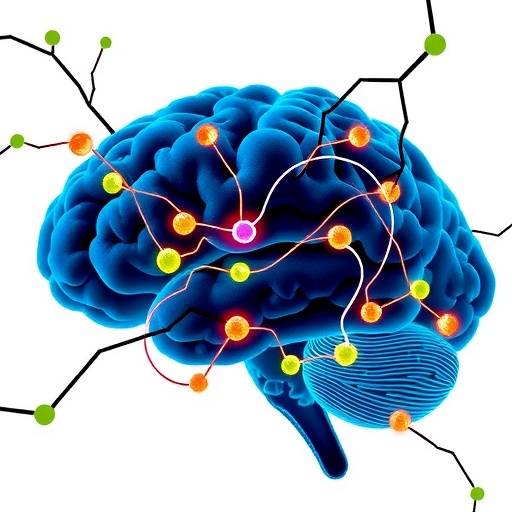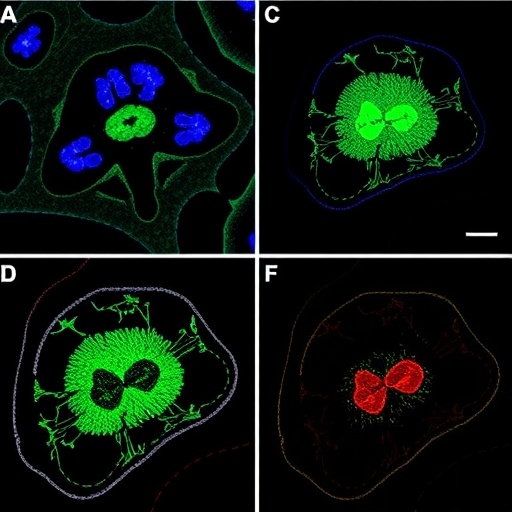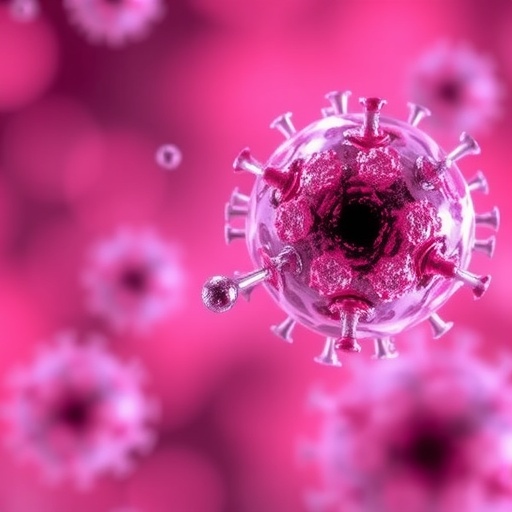In the intricate choreography of cellular behavior, understanding how individual cells navigate their environments is a pursuit that has captivated biologists for decades. Cellular motility underpins numerous physiological processes, from immune surveillance to tissue repair. Yet, this capacity for movement, when hijacked by malignant cells, becomes a sinister driver of cancer metastasis, a primary hallmark of disease progression and patient mortality. A groundbreaking study from Japan now uncovers a pivotal molecular player propelling the notorious spread of glioblastoma, an aggressive brain tumor with dismal prognoses. At the heart of this discovery lies shootin1b, a protein whose aberrant activity catalyzes the swift migration of glioblastoma cells and offers a tantalizing new target for therapeutic intervention.
The cellular milieu is a dynamic landscape where cells constantly interpret and respond to a spectrum of biochemical and mechanical signals. Migratory cells exert forces against their immediate surroundings to advance, employing an elaborate machinery of cytoskeletal elements and adhesion complexes. Although this mechanobiology is well-appreciated in principle, the precise molecular facilitators that translate intracellular cytoskeletal dynamics into effective locomotion remain incompletely understood. The investigative team spearheaded by Professor Naoyuki Inagaki at Nara Institute of Science and Technology ventured to elucidate this enigma, focusing on shootin1b, a protein hitherto less explored in the context of tumor cell motility.
Their meticulous research elucidated that shootin1b functions as a critical molecular clutch system, mechanically coupling intracellular actin filaments—structural proteins responsible for generating propulsive forces—to extracellular adhesive molecules. This clutch transduces the retrograde flow of polymerizing actin at the cell’s leading edge into traction forces that drive cell migration. Intriguingly, the strength of this adhesion–clutch system is finely tuned; it is weak yet sufficient, enabling rapid translocation without compromising cellular responsiveness to directional cues, such as chemoattractants. This nuanced modulation is essential for cells to energetically and efficiently navigate complex environments.
In glioblastoma cells, shootin1b’s machinery is commandeered, resulting in exaggerated motility that fuels invasive behavior, facilitating tumor cell dissemination within the brain parenchyma. This invasive propensity is a principal obstacle in effective glioblastoma management, as disseminated cells resist surgical excision and conventional therapies. The study employed advanced live-cell imaging and molecular perturbations to show that knocking down shootin1b expression markedly inhibits glioblastoma cell motility, validating the protein’s functional role in driving cellular invasion.
The ramifications of these findings extend beyond glioblastoma, encompassing immune cell biology—a domain where controlled motility is imperative. Specifically, the research illuminated shootin1b’s role in dendritic cells, specialized immune sentinels tasked with pathogen capture and antigen presentation. The cell migration process in dendritic cells requires them to generate backward forces on their substratum, propelling them forward in a coordinated manner. Shootin1b-dependent clutch formation is instrumental here as well, converting actin dynamics into effective traction, underscoring a conserved mechanism regulating diverse cell types.
Mechanistically, the actin cytoskeleton’s polymerization at the cell front engenders a backward flow of filaments, a process central to protrusive activity. Shootin1b integrates into adhesion complexes that transiently link this actin flow to the extracellular matrix via integrin and other adhesion molecules. This transient linkage converts actin dynamics into mechanical force, creating traction necessary for locomotion. The weak adhesion characteristic of this system optimizes motility speed, enabling cells to rapidly respond to environmental cues and migrate effectively. This contrasts with stronger adhesion states that, while stabilizing cells, impede quick migration.
Targeting shootin1b forms a conceptual breakthrough in glioblastoma therapy. By suppressing the abnormal activity of shootin1b, the migratory and invasive capabilities of tumor cells can be diminished, potentially curbing tumor spread. Given glioblastoma’s notorious resistance to existing modalities and a scant five-year survival rate hovering around 5%, novel interventions are desperately needed. Shootin1b inhibition could lay the groundwork for innovative therapeutic strategies complementing traditional treatments like surgery, radiotherapy, and chemotherapy.
The research embodies a convergence of experimental rigor and translational promise. Leveraging state-of-the-art molecular biology techniques, including gene knockdown and high-resolution live imaging, the study offers not only fundamental insights into cell motility but also practical avenues for clinical impact. The identification of shootin1b as a molecular clutch protein necessitates reconsideration of the existing paradigms of cellular migration, particularly in pathological contexts.
Furthermore, the discovery elucidates the responsiveness of the adhesion–clutch system to chemoattractant gradients, revealing how external signals modulate intracellular mechanics to influence migration speed and directionality. This fine-tuning capacity facilitates immune cells in homing to infection sites and also explains glioblastoma cells’ invasive adaptability within the brain’s heterogeneous environment. The plasticity endowed by shootin1b-mediated adhesion modulation confers a survival advantage in hostile microenvironments.
As the field advances, the study opens compelling opportunities for drug development. Small molecules or biologics designed to disrupt shootin1b’s interaction with actin or extracellular adhesion molecules could selectively impair cancer cell migration. Importantly, the dual role of shootin1b in immune cell function highlights the necessity for precise therapeutic modulation to avoid unintended immunosuppressive consequences.
The collaborative effort, spanning multiple renowned Japanese institutions, typifies modern interdisciplinary research, marrying cell biology, neuro-oncology, and biomedical engineering. Such synergy not only accelerates discovery but ensures that findings resonate across scales—from molecular mechanisms to organismal physiology and patient outcomes.
In summary, the identification of shootin1b as a pivotal regulator of rapid cell migration and glioblastoma invasion charts a promising course in cancer biology. It deciphers a molecular clutch system that converts cytoskeletal dynamics into the mechanical forces driving movement. Through this lens, the sinister mobility of glioblastoma cells can be viewed as a pathological exaggeration of a natural cellular program. Targeting this process heralds hope for interventions that can diminish tumor dissemination, ultimately improving survival and quality of life for patients afflicted by this formidable disease.
Subject of Research: Cells
Article Title: Weak and Tunable Adhesion–Clutch Drives Rapid Cell Migration and Glioblastoma Invasion
News Publication Date: 13-Aug-2025
Web References: https://doi.org/10.1002/advs.202502074
References: Kentarou Baba, Ami Fukushi-Kumagai, Megumi Morisaki, Ryosuke Takeuchi, Zhize Xiao, Yoshikazu Nagashima, Mizuki Sakai, Yasuna Higashiguchi, Hiroko Katsuno-Kambe, Asako Katsuma, Yoshihiro Ueda, Yuji Kamioka, Daisuke Kawauchi, Tatsuo Kinashi, Yonehiro Kanemura, and Naoyuki Inagaki. “Weak and Tunable Adhesion–Clutch Drives Rapid Cell Migration and Glioblastoma Invasion.” Advanced Science, 2025.
Image Credits: Professor Naoyuki Inagaki from Nara Institute of Science and Technology, Japan
Keywords: Life sciences; Cell biology; Cell migration; Chemotaxis; Glioblastoma cells; Actin cytoskeleton; Cell adhesion; Dendritic cells; Membrane proteins; Cancer cells; Cell membranes; Immune cells
Tags: biochemistry of cancer cell migrationcancer progression and patient mortalitycell migration in brain cancercellular behavior in cancer metastasiscytoskeletal dynamics in cancer cellsglioblastoma cell motility mechanismsmechanobiology of cell movementmolecular interactions in tumor spreadNara Institute of Science and Technology researchshootin1b protein function in cancersignaling pathways in brain cancertherapeutic targets for glioblastoma





